The Greater Roadrunner (Geococcyx californianus) is a captivating bird species native to the arid landscapes of the southwestern United States and parts of Mexico.
Known for its distinctive appearance and behavior, the roadrunner has become an iconic symbol of the region.
With a length of 20 to 24 inches, the bird boasts a slender, elongated body, prominent crest, and a swift running ability that reaches up to 20 miles per hour.
Recognizable by its unique vocalizations, including the famous beep-beep call, the Greater Roadrunner is a fascinating subject of study.
From its cooperative nesting habits to its diverse diet and cultural symbolism, this bird encapsulates the essence of adaptability and resilience in the harsh environments it calls home. Stay sharp.
Identifying Criteria of Greater Roadrunner
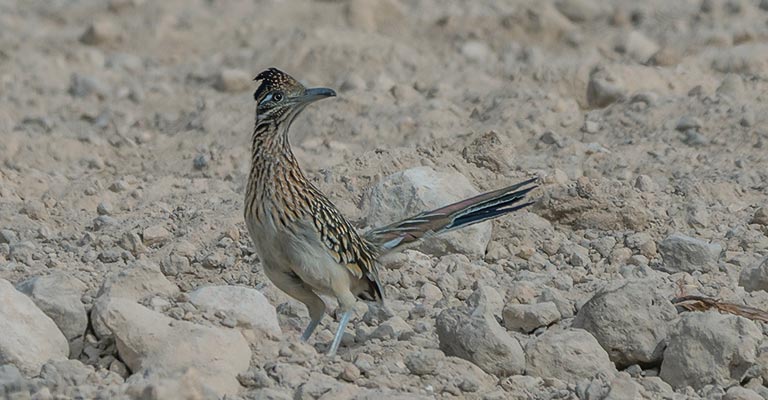
The Greater Roadrunner (Geococcyx californianus) is a distinctive bird species native to the southwestern United States and parts of Mexico.
Recognizable for its unique appearance and behavior, identifying this fascinating bird involves observing several vital characteristics. Here are some points to help you determine the Greater Roadrunner:
Size and Shape
The Greater Roadrunner is a medium-sized bird ranging from 20 to 24 inches long. It has a slim, elongated body, a long tail, and strong legs adapted for running.
Coloration
The plumage of the Greater Roadrunner is a combination of brown, black, and white. Its overall coloration provides effective camouflage in its arid habitat.
The bird’s streaked back and wings, along with a distinctive crest on its head, contribute to its unique appearance.
Distinctive Crest
One of the most noticeable features of the Greater Roadrunner is the erectable crest on its head. The crest consists of a series of black and white stripes, and the bird can raise or lower it depending on its mood or alertness.
Facial Features
The bird has a distinctive facial profile with a bare skin patch around its eyes. The eyes are yellow and surrounded by a white eye ring, adding to the bird’s expressive and captivating look.
Long Tail with Dark Tip
The Greater Roadrunner’s tail is long and graduated, with a stepped appearance. The tail is often carried at an upward angle and has a dark tip, which contrasts with the rest of the tail feathers.
Ground-Dwelling Behavior
True to its name, the Greater Roadrunner is known for its exceptional running ability.
It spends significant time on the ground, running at impressive speeds to catch prey. Observing its terrestrial behavior is a crucial aspect of identification.
Distinctive Vocalizations
The Greater Roadrunner produces a series of unique vocalizations that contribute to its identification.
Its calls include a cooing sound, a soft chattering, and a distinctive “beep-beep” noise, which has become iconic in popular culture.
Habitat Preference
The bird’s habitat preferences aid in identification. Greater Roadrunners are common in arid and semi-arid regions, including deserts, open woodlands, and scrublands. They are often seen running along roadsides, which is another reason for their name.
Identifying the Greater Roadrunner involves a combination of size, coloration, distinctive features such as crest and facial markings, behavior, vocalizations, and habitat preferences.
These unique characteristics make the Greater Roadrunner a captivating and recognizable bird in its native range.
Taxonomy of Greater Roadrunner
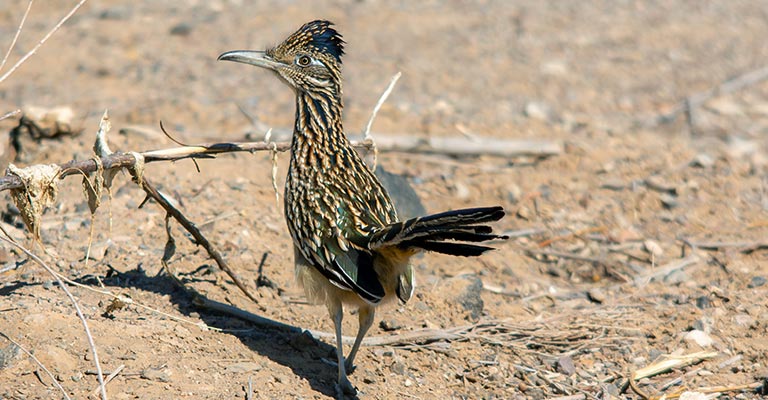
Here’s a table that showcases all the taxonomy details of the Greater Roadrunner:
| Taxonomic Level | Classification |
| Domain | Eukaryota |
| Kingdom | Animalia |
| Phylum | Chordata |
| Class | Aves |
| Order | Cuculiformes |
| Family | Cuculidae |
| Genus | Geococcyx |
| Species | G. californianus |
The Greater Roadrunner (Geococcyx californianus) belongs to the family Cuculidae and the order Cuculiformes.
This bird’s taxonomic classification places it within the genus Geococcyx alongside its close relative, the Lesser Roadrunner.
Cuculidae encompasses a diverse group of birds commonly known as cuckoos. The order of Cuculiformes includes various species of cuckoos and anis.
The Greater Roadrunner, known for its distinctive appearance and behavior, is characterized by its long legs, strong running ability, and unique vocalizations.
This bird’s taxonomic classification provides insights into its evolutionary relationships and placement within the broader avian family tree.
Reproduction of Greater Roadrunner
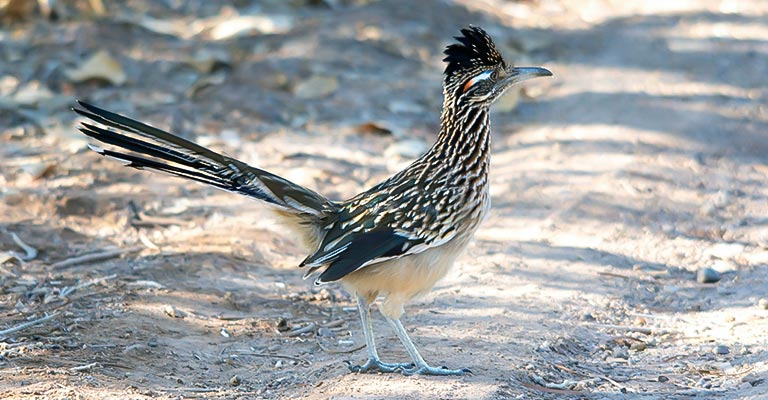
The Greater Roadrunner follows a monogamous mating system, forming long-term pair bonds. Breeding typically occurs from March to September.
The female lays 2 to 6 eggs in a well-concealed ground nest made from twigs and other vegetation. The male and female are responsible for incubating the eggs, which lasts about 20 days.
After hatching, the parents continue to cooperate in caring for the chicks, providing them with a diet of insects, lizards, and small mammals.
The young birds fledge in approximately 18 days but remain dependent on their parents for several weeks.
The Greater Roadrunner’s reproductive habits reflect a cooperative and involved approach to parenting, contributing to their offspring’s success in their arid environments.
Greater Roadrunner Life History
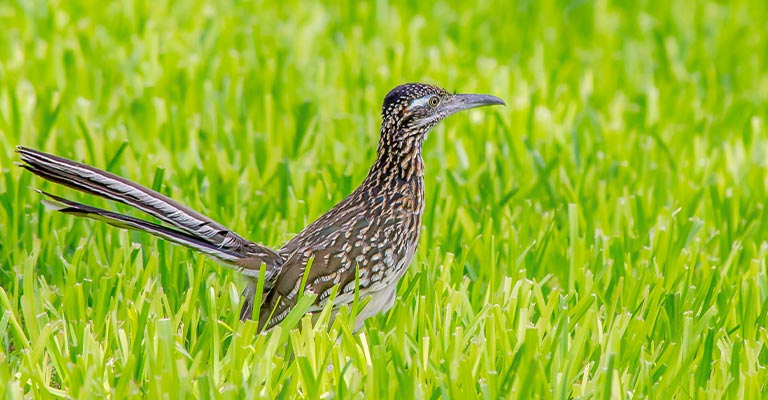
The Greater Roadrunner (Geococcyx californianus) is a fascinating bird species known for its unique appearance and behavior.
Native to the southwestern United States and parts of Mexico, the life history of the Greater Roadrunner encompasses various aspects of its ecology and survival strategies.
Food
Greater Roadrunners are opportunistic carnivores, primarily feeding on insects, lizards, small mammals, snakes, and occasionally fruits and seeds.
Their remarkable running ability enables them to chase down prey, while their sharp beaks aid in capturing and consuming a diverse range of food.
Habitat
These birds are well-adapted to arid and semi-arid environments, including deserts, scrublands, and open woodlands. They often inhabit areas with a mix of vegetation, providing suitable cover for nesting and foraging.
Range Map
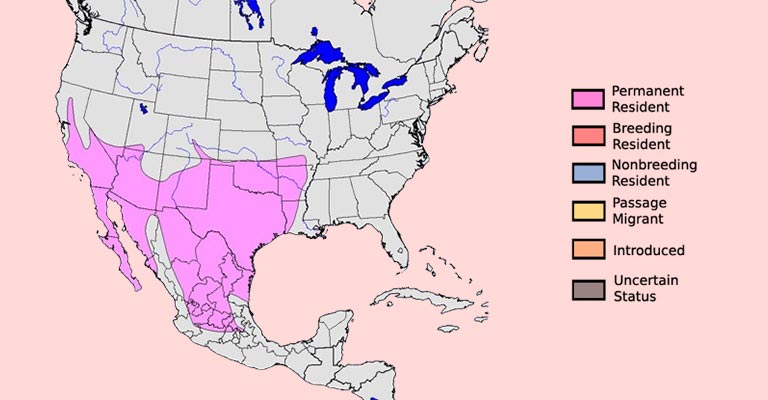
The Greater Roadrunner’s range spans the southwestern United States, including California, Arizona, Texas, and parts of Mexico.
A detailed range map helps researchers and conservationists understand the distribution of this species and implement targeted conservation efforts.
Nesting
During the breeding season, typically from March to September, Greater Roadrunners construct nests made of twigs, leaves, and other vegetation on the ground.
The female lays a clutch of 2 to 6 eggs, and both parents take turns incubating the eggs and caring for the young after hatching.
Diseases
While Greater Roadrunners face various environmental challenges, diseases can also affect their populations.
Avian diseases, such as West Nile Virus, can pose a threat. Monitoring and understanding disease prevalence in these birds is crucial for conservation efforts.
Treatment
In cases where diseases impact Greater Roadrunner populations, wildlife rehabilitators and veterinarians may intervene.
Treatment may involve supportive care, quarantine measures, and research into potential causes and preventive measures to mitigate the impact of diseases.
Conservation
Conservation efforts for the Greater Roadrunner focus on preserving and restoring suitable habitats, managing potential threats such as habitat loss and fragmentation, and raising awareness about the importance of these birds in maintaining ecological balance.
Collaborative initiatives involving researchers, policymakers, and local communities contribute to the overall conservation of this species.
The life history of the Greater Roadrunner is a testament to its adaptability and resilience in arid environments.
Nesting Habit of Greater Roadrunner
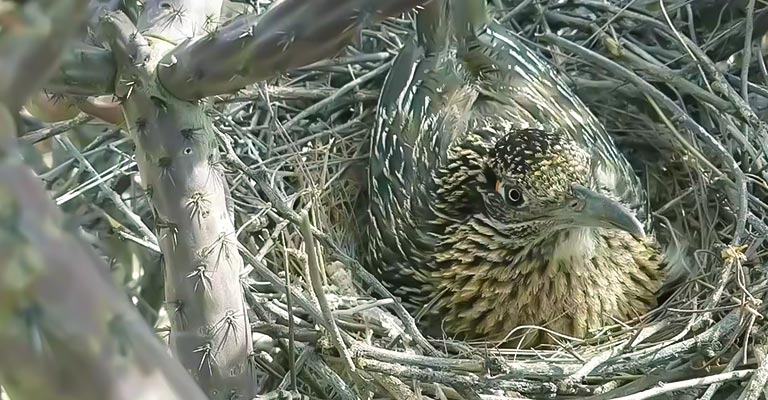
Here is a table summarizing the nesting details of the Greater Roadrunner (Geococcyx californianus):
| Nesting Details | Facts |
| Clutch Size | 2 to 6 eggs |
| Number of Broods | Usually 1 per breeding season |
| Egg Length | Approximately 2 inches (5 cm) |
| Egg Width | About 1.5 inches (3.8 cm) |
| Incubation Period | Around 20 days |
| Nestling Period | Approximately 18 days |
| Egg Description | Pale, plain white with a smooth surface |
| Nesting Site | Ground nests made of twigs and vegetation |
| Parental Involvement | Both male and female share incubation and care duties |
| Nesting Season | Primarily from March to September |
These nesting details provide insights into the reproductive behavior and life cycle of the Greater Roadrunner.
Their cooperative nesting and parenting strategies contribute to the survival and well-being of their offspring in their arid habitat.
5 Fun Facts About Greater Roadrunner
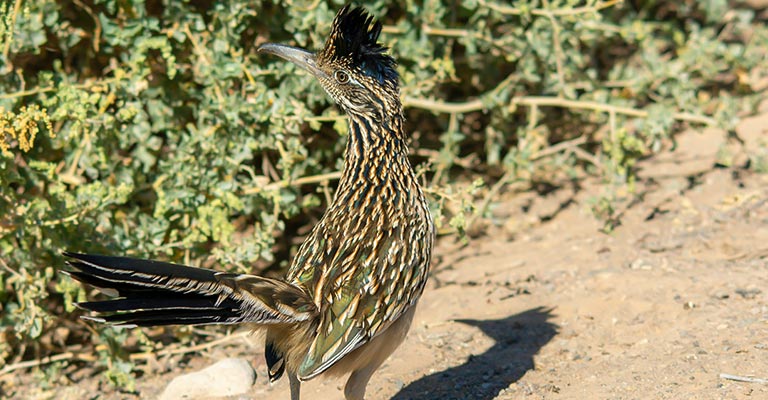
Check out the following 5 fun facts about the Greater Roadrunner. These will help you in the long run.
Sprinters of the Desert
Greater Roadrunners are renowned for their impressive running speed, capable of reaching up to 20 miles per hour. They use their speed not only for hunting but also to escape predators.
Iconic Beep-Beep Call
The distinctive “beep-beep” sound commonly associated with the Greater Roadrunner is a characteristic vocalization. They produce a variety of calls, including coos and chatters, contributing to their expressive communication.
Survival Tactics Against Snakes
Roadrunners are known for their unique method of dealing with snakes. When encountering a venomous snake, they can pick it up and smash it against the ground to kill it, thus eliminating the threat to themselves and their nests.
Versatile Diet
Despite being bird species, Greater Roadrunners have a diverse diet. They consume insects, small mammals, lizards, snakes, and even fruits and seeds. This adaptability allows them to thrive in various environments.
Cultural Symbolism
The Greater Roadrunner holds cultural significance in Native American folklore. In some traditions, it is considered a symbol of protection and good fortune.
Additionally, the roadrunner has become a pop culture icon, featuring in cartoons like “Looney Tunes,” where a character named “Road Runner” is known for its speed and elusive nature.
Wrapping Up
The Greater Roadrunner stands out for its unique physical traits and behaviors and its remarkable adaptability in arid environments.
From its swift running capabilities to cooperative nesting habits, this bird showcases an intriguing blend of survival strategies. Its symbolic significance in culture and the iconic beep-beep call further contribute to its charm.
Understanding the life history, nesting habits, and cultural impact of the Greater Roadrunner sheds light on the intricate dynamics of this species in its southwestern habitats.
Conservation efforts are essential to preserving the delicate balance of its ecosystem and ensuring the continued existence of this iconic bird—best of luck.